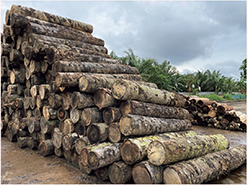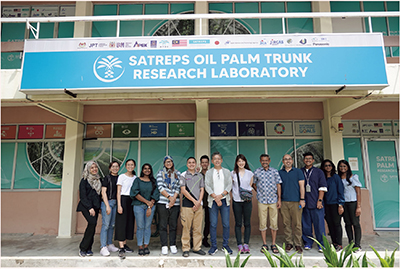MASTER TECHNIQUES from Japan to the World 3
Contributing to Malaysia’s Palm Oil Industry with Technology from Japanese Small and Medium-Sized Enterprises (SMEs)

Trunks of old oil palm trees logged and piled up in an oil palm plantation (Photo: KOSUGI Akihiko)

Dr. Kosugi (seventh from the right) and students engaging in the research in front of the SATREPS Oil Palm Trunk Research Laboratory launched at USM (Photo: KOSUGI Akihiko)
Malaysia is a major producer of palm oil, which is extracted from oil palm fruits, and its exports amount up to approximately 2 trillion yen. However, the problem of processing agricultural waste, such as oil palm trunks (OPT), which are produced when cutting down old palms, as well as oil palm fronds and empty fruit bunches, has become an issue for which a balance between development and environmental protection is required. Oil palm trees are logged and replanted approximately every 25 years to maintain oil production levels. Consequently, as many as 75 million old oil palm trees are cut down every year. Abandoned OPT on the plantation sites not only emits greenhouse gases, including methane gas, but also causes the spread of soil-borne diseases, making it difficult to reuse the land in some cases.
In response to this situation, the Japan International Research Center for Agricultural Sciences (JIRCAS) implements the “Project on Sustainable Replantation of Oil Palm by Adding Value to Oil Palm Trunk through Scientific and Technological Innovation” from 2019 as part of the Science and Technology Research Partnership for Sustainable Development (SATREPS)Note 1 in collaboration with the University of Science, Malaysia (USM). This project conducts scientific and economic assessments of the negative impact of abandoning OPT after logging. It also examines ways to maintain the healthy state of palm plantations by upcycling OPT without abandoning them on site, and to sustain palm plantations without expanding their acreage. To this end, JIRCAS and USM work to develop technology for manufacturing high-value-added products from OPT and to demonstrate its effectiveness, as important targets.
Project leader Dr. KOSUGI Akihiko, who has been conducting research on the utilization of OPT waste at JIRCAS since 2004, talks about the achievements of this project as follows. “We presented our research findings on the impact of OPT abandonment on soil to the Government of Malaysia and plantation owners, which helped them understand the benefits of removing waste from the plantation sites. The use of palm biomass is increasing both in Japan and overseas by turning collected waste materials into useful products such as fuel pellets, plywood, and fertilizer. For example, Panasonic Corporation developed a technology called “PALM LOOP” that makes upcycled wooden boards from oil palm waste. Thanks to this technology, the waste wood can now be used as a material for furniture. By implementing research results in the real world, we aim to add value to OPT as a resource and create new industries.”
In a pilot project to commercialize OPT, the knowledge of Japanese engineers and the technical skills of local factories in Japan were utilized to develop a “Multi Biomass Treatment Process” that reduces the environmental impact of pellet manufacturing. This process can pelletize not only OPT waste but also its branches and fronds, as well as empty fruit bunches discharged from palm oil factories. The project intends to achieve carbon neutrality in the palm oil industry by disseminating this process in the future. In addition, it reaches out to the agencies of the Government of Malaysia to certify not only palm oil but also the biomass produced by the palm oil industry as a sustainable product.
Dr. Kosugi aims to collaborate with Japanese companies to realize the social implementation of the palm biomass project, including this OPT waste material: “Since this series of results was achieved by combining the brilliant and superior technology of Japanese SMEs concentrated in downtown areas called Shitamachi, we named it the ‘Shitamachi Biomass’ initiative. We hope to apply this concept to the export industry not just in Malaysia but also in the entire Southeast Asian region, utilizing Japanese technology for the world while also revitalizing Japanese manufacturing itself.”
Dr. Kosugi launched a venture company in 2022 in view of continuing the project after its conclusion in the SATREPS framework. “The shortest way for the social implementation of the technology we have developed is to create our own way for its use. For the people of Malaysia, it is important to ensure profitability first, but on top of that, it is important to raise environmental awareness. We would like to continue working to expand the biomass business in Malaysia by achieving both the stabilization of the procurement of raw materials and commercial viability of the factory, which will lead to sustainable land use and environmental conservation,” says Dr. Kosugi about his future prospects.
Note 1: See the glossary.
<< Previous Page Next Page >>
Main Text | Reference Statistics | Stories from the Field | Master Techniques from Japan to the World | ODA Topics
